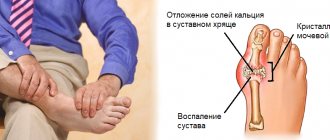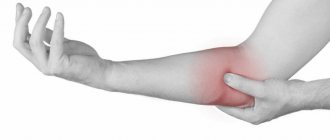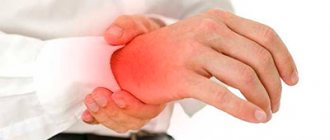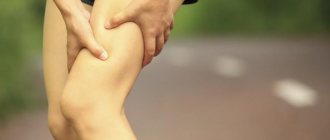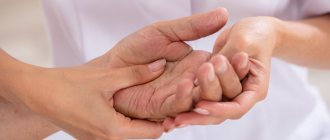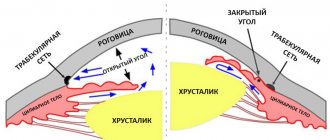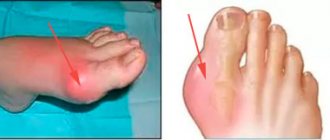Video
- Joint pain. Question answer. Topic: Encyclopedia of diseases
- Joint pain Topic: Encyclopedia of diseases
Title
- Major diseases
- Myths and facts
- Diagnostics
- Treatment methods
Joint pain can be mild in intensity or severe and debilitating. Over the course of their lives, up to 85% of the adult population will experience joint pain in one way or another. The cause of joint pain can be hundreds of diseases, in which joint damage can be either primary or secondary (due to intoxication with metabolic products).
The following diseases are most often accompanied by joint pain:
- Osteoarthritis
- Rheumatoid arthritis
- Rheumatism
- Reactive arthritis
- Psoriatic arthritis
- Bursitis
- Gout
- Myeloma
- Lyme disease
- Osteomyelitis
- Systemic lupus erythematosus
- Scleroderma
- Lymphoblastic leukemia
- Sarcoidosis
- Kawasaki disease
- Crohn's disease
- Still's disease
- Bone metastases
- Septic arthritis
Statistically, 4 diseases with the presence of arthralgia (joint pain) deserve the most attention.
Osteoarthritis
Arthritis (inflammation of the joint) is the most common cause of joint pain and a very large number of people suffer from this disease. Osteoarthritis is sometimes called degenerative, meaning that the cartilage tissue lining the surfaces of the joint undergoes degenerative changes over time and damaged cartilage injures each other, causing symptoms such as joint pain, inflammation, stiffness and limited mobility. Osteoarthritis affects approximately 27 million people in the United States. Symptoms usually begin after age 40 and progress slowly. And after the age of 60, up to half of people experience this disease to one degree or another. Osteoarthritis most often affects large joints that are subject to greater stress (hips, knees and ankles). Increased weight increases the risk of this disease. It has been noted that people with increased weight (both men and women) are three times more likely to develop this disease compared to people with normal weight (the same age and gender group).
Causes of aching joints
Mild or moderate joint discomfort is not always a manifestation of a pathological process. Sometimes the symptom has natural causes. Transient aching of the joints is felt when wearing uncomfortable shoes, and in weather-sensitive people - when the weather changes. During puberty, aching sensations in the shoulder and knee joints are caused by insufficient blood supply due to accelerated bone growth.
Significant physical activity
During intense training or heavy work, a common cause of the symptom is overstrain of the musculo-ligamentous system, less often it is caused by microtraumas of the cartilage and synovium. A typical combination of aches in the joints and discomfort in the bones and muscles. Joint and muscle discomfort occurs immediately after impact physical activity or against the background of prolonged monotonous work with constant tension in the same muscle groups. Aches in the joints of the body occur without fever. With large overloads, a moderate violation of the general condition and weakness is possible.
The disorder can last up to several days and, with limited physical activity, gradually decreases until it disappears completely without any treatment. If aches and pains resulting from sports or heavy physical work are replaced by persistent pain, swelling in the wrist, elbow, shoulder, ankle, knee and hip joints, and limitation of usual movements, you should visit a doctor.
Age-related changes in the musculoskeletal system
The causes of moderate aches in bones and joints in older people are degenerative processes with loss of calcium, thinning of bone beams, impaired blood supply to cartilage and a decrease in the volume of intra-articular fluid. Mild discomfort is only the first manifestation of senile joint damage. Typically, periodic discomfort occurs after 45-50 years. By the age of 60-65, an unpleasant ache occurs even with minor exertion, accompanied by stiffness of movement, stooping, shuffling gait, and gradually gives way to pain.
Pregnancy
Complaints about aching joints are more often made in the second half of the gestational age. Pulling, aching discomfort is usually felt in the joints of the pelvis and lower extremities. It intensifies towards the end of the day, after prolonged standing or walking long distances. A night's rest eases the condition. Joint pain during pregnancy is caused by the following reasons:
- Vitamin and mineral deficiency
. The greatest role is played by calcium and vitamin D deficiency, leading to osteomalacia. A feature of the manifestation of the symptom is a feeling of aching not only in the joints, but also in the bones, fatigue, the presence of other signs of hypocalcemia and hypovitaminosis D - caries, brittle nails, muscle weakness, muscle pain, and the frequent occurrence of ARVI. - Significant weight gain
. Joint discomfort is more often a concern for pregnant women with large weight gain or those who are obese. Aches at the end, and eventually in the middle of the day, are felt in the hip joints, knees, ankles, the cartilages of which experience loads several times higher than permissible. To alleviate the condition, women deliberately limit physical activity, which leads to even faster weight gain. - Softening of cartilage and ligaments
. About half of pregnant women experience discomfort in the joints of the pelvis caused by the action of the hormone relaxin. In most cases, the discomfort is in the nature of aching in the pubic area and hip joints. In a pathological course with the development of symphysitis, aching sensations are replaced by pain, which intensifies when pressing on the womb, trying to separate the legs, during sex. The appearance of pain in the pubic area is a serious reason for a visit to an obstetrician-gynecologist. - Carpal tunnel syndrome
. A specific manifestation found in the 2-3 trimesters in almost 20% of pregnant women is the so-called tunnel syndrome. The cause of the disorder is swelling of the soft tissues of the hands and compression in the carpal tunnel of the nerves that pass to the fingers. In addition to aching pain in the small joints of the hand, patients complain of numbness of the skin, tingling, and a crawling sensation. The condition improves with an elevated position of the arms.
Obesity
In overweight people, pressure on cartilage tissue increases, causing it to wear out faster. The degenerative-dystrophic process usually involves large joints of the lower extremities and intervertebral joints. The disorder increases as obesity progresses. Discomfort in the joints first manifests itself in the form of aches without fever by the end of the day, then the increasing destruction of cartilage leads to the development of deforming arthrosis, spondylosis, osteochondrosis with a sharp pain syndrome that limits the patient’s motor activity.
Acute infections
Body and joint aches are one of the early (prodromal) signs of many acute respiratory viral infections. The main causes of joint discomfort are intoxication of the body due to the spread of viruses and bacteria, the accumulation of toxins, and the development of the inflammatory process. Usually the patient complains that the whole body aches, mild and moderate pain is noted both in the joints and in the muscles and bones. The symptom is accompanied by weakness, fatigue, insomnia, and frequent awakenings. Simultaneously with signs of aches and general malaise, chills and hyperthermia are observed.
The most pronounced aches in the joints and body are with the flu. Up to 50% of patients experience constant aching pain in the legs, arms, and torso. The intensity of pain is so high that it becomes difficult for a person to perform the simplest actions - get out of bed, go to another room, pick up a glass of water. The situation is aggravated by high (febrile) temperature and severe headaches. Sore throat and nasal congestion occur after a few hours or even days. Less joint discomfort occurs with parainfluenza, an adenoviral infection.
A feeling of aching in the joints is possible with acute infectious lesions of the gastrointestinal tract - food toxic infections, salmonellosis. Aching joint pains of varying intensity appear suddenly a few hours after consuming contaminated foods and are combined with a sharp rise in temperature, severe chills, and headaches. Aches are preceded by nausea, vomiting, pain in the abdominal cavity, foul-smelling diarrhea with mucous and sometimes bloody impurities.
Joint pain can be a symptom of a wide range of diseases
Collagenoses
Aching joints are a harbinger of most diseases that occur with autoimmune inflammation of connective tissue, including joint tissue. The localization, prevalence, and intensity of unpleasant sensations are determined by the characteristics of a particular collagenosis. The general patterns are the involvement of certain groups of joints in the process, a gradual increase in sensations to excruciating debilitating pain, observed first during movements, and then at rest. Deformation of the articular joints is possible. The main systemic inflammatory causes of the disorder:
- Rheumatism
. The symptom is “volatile”: aching aches and then pain are felt in turn in the large joints of the arms and legs - elbows, shoulders, hips, knees, ankles. The affected areas are swollen. Joint discomfort is often preceded by a sore throat. With treatment, changes in the joints are reversible. - Rheumatoid arthritis
. Unpleasant sensations often appear after 40 years. A typical feeling of aching in the small joints of the hands and feet, combined with noticeable swelling and morning stiffness of movement. In the future, pain and curvature of the articular joints come to the fore. - Systemic scleroderma
. It is characterized by variable localization of aching sensations, the presence of stiffness in the morning in the joints of the hands, elbows, and knees. Aches and pain are usually symmetrical. The swelling is short-lived. Due to skin sclerosis, the mobility of the articular joints is limited, damage to the tendons causes a feeling of friction when moving.
Osteoarthritis
The pain syndrome in the initial stages of the disease is mild and is perceived as discomfort, aching in the joints of the legs, and less often, the arms. The immediate cause of osteoarthritis is degeneration and destruction of cartilage tissue. Typically, pulling or aching sensations without fever appear in adulthood and old age. Aching may begin earlier in the presence of occupational hazards (vibration, heavy physical labor). Gradually, the joints become stiff, the person experiences severe pain and difficulty walking and caring for himself.
Metabolic disorders
The causes of metabolic disorders in which joint pain occurs are insufficient supply of vitamins, minerals, accelerated accumulation or excessive excretion of metabolic products. Unpleasant sensations are caused by inflammatory or dystrophic processes, have varying severity and most often serve as a manifestation of pathological conditions such as:
- Osteoporosis
. When calcium is washed out of bone tissue, the articular surfaces of the bones become fragile, the cartilage becomes thinner, which is accompanied by aching sensations. The pain syndrome increases gradually from mild aches to severe arthralgia, combined with unpleasant sensations in the bones and muscle weakness. The joints that experience the maximum load are most often affected - the hip and knee; the shoulder, elbow, and ankle are less commonly affected. - Gout
. A slight ache in the big toe is already a concern at the preclinical stages of the gouty process. There may be aching discomfort in the knees, elbows, wrists, and fingers. The accumulation of urates in the joint cavity leads to a rapid manifestation of the disease with a change from aching to acute painful joint pain that does not subside for several hours. The affected joint is hot to the touch. There is redness of the skin and limited movement.
Oncological diseases
In acute and chronic leukemia, widespread osteoarticular aches, followed by pain, often occur even before noticeable pathological changes in a general blood test and other clinical symptoms - general malaise, night sweats, fever, loss of appetite, bleeding. The unpleasant sensations are at first periodically aching, then constantly strong, debilitating the patient.
Hodgkin's lymphoma and lymphogranulomatosis are characterized by a combination of aching joints with muscle discomfort, weakness, enlarged lymph nodes and other lymphoid formations. Aching sensations are common, usually moderate. A short period of aching in the knee joint and thigh muscles, which intensifies at night, and with exertion turns into constantly increasing pain with lameness, is observed with osteosarcomas. Other joints are less commonly affected by this pathology.
Joint injuries
Joint aches are provoked by mild traumatic injuries, which cause damage to the ligaments surrounding the joint and bruise of the soft tissues of the articular area. More severe pain occurs when the meniscus is damaged. The symptom is clearly related in time to a blow, a fall, or an awkward movement. Usually discomfort is felt in one affected joint, less often spreading to adjacent areas of the body.
Chronic infectious processes
Possible causes of a feeling of aching joints that occurs without fever or against the background of low-grade fever are long-term infections. In patients suffering from chronic infectious and inflammatory diseases, joint discomfort becomes a consequence of intoxication of the body or direct damaging effects of microorganisms on joint tissue (usually streptococci, mycoplasmas, chlamydia). The appearance or intensification of pain may indicate an exacerbation of chronic tonsillitis, sinusitis, genitourinary infections, adnexitis, pyelonephritis.
Distinctive features of joint pain in common chronic infections that occur with intoxication are moderate severity of joint discomfort, gradual development, periodic intensification and weakening of symptoms. In patients suffering from tuberculosis and hematogenous osteomyelitis, the background for the development of aching painful sensations is an increase in temperature to subfebrile levels, general malaise - fatigue, weakness, weakness. Without treatment, the condition of patients progressively worsens.
Complications of pharmacotherapy
Taking some medications may be complicated by aches and moderate pain in the small joints of the hands. Unpleasant sensations are not accompanied by redness or deformation of the joints. Patients may complain of muscle aches, fever, skin rashes, and other manifestations of drug allergies. Discomfort quickly disappears after discontinuation of the drug that provoked it, and special treatment for complications that arise is less likely to be required. Aches and mild arthralgia are caused by:
- Antibiotics
: penicillins, fluoroquinolones. - Tranvilizers
: phenazepam, diazepam, lorazepam, etc. - Contraceptives
: combined oral contraceptives (COCs).
Rare causes
- Inflammation of the respiratory system
: pneumonia, bronchitis, tracheitis. - Intestinal pathology
: nonspecific ulcerative colitis, Crohn's disease. - Skin diseases
: psoriasis. - Endocrine disorders
: diabetes mellitus, diffuse toxic goiter, hypothyroidism, Itsenko-Cushing's disease. - Autoimmune processes
: Hashimoto's thyroiditis, vasculitis. - Damage to the fascia
: necrotizing fasciitis in the convalescent stage. - Congenital defects of bones and joints
.
Rheumatoid arthritis
An autoimmune disease that causes pain and stiffness in the joints. Most often it occurs in women aged 20 to 50 years. There are about 1.5 million patients with this diagnosis in the United States. In patients with this disease, due to disruption of the immune system, antibodies are formed to their own tissues (including joint tissues), which causes inflammatory processes and manifests itself as damage to joints and other internal organs. Inflammation in the joints leads to rapid wear, pain and limited mobility. Due to the fact that the disease is systemic and autoantibodies spread throughout the body, joint damage is symmetrical (joints on the right and left are affected). Small joints (in the hand and foot) are often affected, as well as large joints.
Why do joints hurt?
Joints are located at the junction of bones and provide motor and support functions.
A person has 38 such points. There are a total of 76 joints in the body. Their defeat leads to limited mobility, which negatively affects the quality of life and its duration. The main reasons for the development of joint diseases are:
- injuries;
- excessive fullness;
- physical exercise;
- poor posture;
- flat feet;
- hereditary predisposition;
- lack of microelements;
- pathologies of internal organs;
- metabolic disorder;
- operations;
- infections.
Problems arise at any age, regardless of gender. Even athletes who are initially in better health regularly undergo treatment for joint diseases. Problems are possible in children, as well as boys and girls.
Bursitis
This disease is often confused with arthritis, although with bursitis it is not the joint that is inflamed, but the joint capsule. Bursitis can cause discomfort, stiffness and pain in the joint area. Symptoms are associated with inflammation of the synovial membranes of the joint, usually caused by improper movement, compression or injury. Most often, bursitis develops in the shoulder, knee or hip joints. One type of bursitis, called maid's knee, develops due to prolonged pressure on the knee joint on a hard surface.
Risk groups by age and gender
Joint diseases manifest themselves mainly in old age - against the background of natural wear and tear of tissues. The risk group also includes those who have received weak bone joints genetically - by inheritance, as well as those suffering from diabetes, obesity, and chronic ailments. But there are other trends.
- Juvenile rheumatoid arthritis occurs among minors.
- Gout develops as a result of excessive consumption of meat, chocolate and red wine, and is therefore considered a “disease of aristocrats”.
- Women often experience inflammation of the joints caused by hormonal fluctuations.
- In men, diseases of a traumatic nature predominate.
Arthrosis is no longer considered a disease of the elderly: recently it has become noticeably younger
Gout
Gouty joints usually involve paroxysmal episodes of pain, stiffness, inflammation and redness in the joints. The reason for this lies in the excess production of uric acid, which is not completely utilized by the kidneys and is deposited in the form of crystals in the joints, which leads to inflammation. As a rule, this disease develops after 50 years. Therefore, it must be remembered that with age, the excretory function of the kidneys may decrease, which can lead to gout. Gout usually affects the feet, but if left untreated, other joints can also be affected.
Systemic lupus erythematosus
Systemic lupus erythematosus is an autoimmune disease. The etiology of this disease is not yet known. A certain genetic determination is assumed. Provoking factors may be infections, stress, sun exposure, ultraviolet radiation, changes in hormone levels during pregnancy or when taking contraceptives. The reason for the formation of autoantibodies is unclear. Women get sick 9 times more often than men and, as a rule, the onset occurs at fertile age. SLE is characterized by alternating exacerbations and remissions, and these periods can be of varying lengths. During an exacerbation, there may be a rise in temperature, inflammation and pain in the joints. Periods of remission can be long and during this period up to 20% of patients do not require treatment. With SLE, damage to other organs and systems (kidneys, heart, skin) is possible.
Myths and facts
Myth N1
All joint pain is associated with arthritis. Although there are at least 50 types of arthritis, inflammation and pain in the joints does not mean the presence of arthritis. Pain in the joint area may be associated with damage to soft tissue or synovial membranes (bursitis). Therefore, a doctor’s consultation is necessary to make a diagnosis.
Myth N2
Clicking your joints causes arthritis. As far as we know, the click when extending a joint is associated only with the vacuum effect and nothing more.
Myth N3
Physical exercise causes joint pain. Exercise is beneficial for both people with arthritis and healthy people. Only if you have pain, you should forget about intense exercise and limit yourself to light gymnastics or exercise on exercise bikes and swimming. It must be remembered that the more a person moves throughout his life, the better. For joints, exercises help maintain range of motion. We must remember the motto “what doesn’t work, perishes.”
Myth N4
It is impossible to stop the process of destruction of joints due to arthritis. Modern drugs (NSAIDs, steroids, antirheumatic drugs) can reduce inflammation, relieve pain and, thus, inhibit destructive processes in the joint. When patients refused treatment for joints, irreversible, pronounced changes in the joints were noted, and, sometimes, in a very short period of time (3-6 months). Therefore, it is better to listen to the advice of your doctor - this will help maintain your quality of life.
Fact N1
Patients with arthritis are weather sensitive. They do not tolerate wet weather well and thrive in dry, clear weather. This is due to the sensitivity of these patients to atmospheric pressure.
Fact N2
Diet may be a factor in preventing arthritis. Yes and no. As you gain weight, your risk of osteoarthritis increases, especially affecting the hips and knees. But for other forms of arthritis, the effectiveness of the diet is not so obvious.
Vascular pain
Pain in the legs of vascular origin is most often associated with obliterating endarteritis, varicose veins of the lower extremities, and thrombophlebitis.
With endarteritis, pain occurs during exercise and goes away after rest or if the legs are lowered down. Approximately the same symptoms accompany atherosclerosis of the vessels of the lower extremities, when the lumen of the vessels narrows and the tissues suffer from a lack of oxygen6.
Thrombophlebitis and varicose veins often accompany each other. Due to the weakness of the vascular wall, the veins expand, become deformed, and blood flow in them is disrupted. There is pain, a “humming” sensation, and heaviness in the legs. By the end of the day, the legs swell, but when you lift them up, it becomes easier7.
Thrombophlebitis is an acute dangerous condition in which pain in the leg occurs suddenly and has a bright, burning, pulsating character. At the site where the blood clot appears, a dense formation is felt inside the vein. The temperature may rise and the area of the leg may turn red. In this condition, you need to urgently contact an angiosurgeon8.
Arthritis
It is a misconception that arthritis only affects older people. These diseases occur in any age group. Arthritis is a disease characterized by inflammation of the joints and affects both children and adults. The typical manifestation of arthritis is pain and stiffness in the joints, which limits movement and sometimes these symptoms are resistant to treatment. Often, it is possible to achieve a therapeutic effect with the help of exercise, medication and lifestyle changes. About 46 million adults in the United States have been diagnosed with a form of arthritis, and that number is trending upward. But arthritis did not appear today and has been bothering people for hundreds of years (typical changes in bone structures discovered during excavations indicate this). It’s just that over the past 100 years there has been a sharp increase in the diagnosis of diseases of the musculoskeletal system and the immune system. Scientists have identified at least 100 types of arthritis and, as it turns out, many conditions accompanied by fever and a malfunction of the immune system are somehow related to the joints.
Arthritis is characterized by pain, stiffness and swelling in the joints, as well as a decrease in the range of movement in them. There are various forms of arthritis, incl. secondary (gout, SLE, fibromyalgia). Arthritis can be divided into three groups:
- Osteoarthritis. Also called degenerative joint disease, it is the most commonly diagnosed form of arthritis. Osteoarthritis occurs when the process of disintegration of cartilage tissue in joints begins. This form of arthritis most often affects the hip, knee, ankle and shoulder joints. It most often develops over the age of 40 years.
- Rheumatoid arthritis. This type of arthritis occurs when the surfaces lining a joint are damaged, causing pain and inflammation. Small joints (feet, fingers) are most often affected. Rheumatoid arthritis is an autoimmune disease that typically develops in women between the ages of 30 and 50.
- Juvenile arthritis. This group includes all arthritis that develops before the age of 18 years. It is not clear what causes the development of arthritis at a young age, but JA occurs more often in girls than in boys. Juvenile arthritis can involve various joints (ankle, knee, hip, shoulder, wrist). There are many types of juvenile arthritis, but juvenile rheumatoid arthritis is the most common.
What joint diseases can cause pain?
There are more than a hundred such diseases. In the elderly, arthrosis is widespread, and in the young, rheumatoid arthritis and injuries (bruises, fractures, ligament damage) are widespread.
“Together with arterial hypertension, which is commonly called hypertension, joint diseases lead the list of the most common reasons for seeking medical help. And the chronic pain that patients experience and because of which they cannot fully live and work is not only a medical, but also an important social problem,” says Doctor of Medical Sciences, Professor of the Department of Rheumatology of the Russian Medical Academy of Continuing Professional Education, senior lecturer educational department of the Research Institute of Rheumatology named after. V.A. Nasonova Natalya Vladimirovna Chichasova. – Of all joint diseases, arthrosis is the most common. 97% of those over 65 years old suffer from this disease. And if we talk about chronic inflammatory diseases of the joints - arthritis, rheumatoid arthritis comes to the fore. It is also not a gift, and not only because of the pain syndrome: already 3-5 years after its onset, this type of arthritis inevitably ends with the patient being assigned a disability group.”
Diagnosis of arthritis
As soon as symptoms of arthritis appear, namely joint pain, you should consult a doctor. A number of diagnostic tests may be required for diagnosis:
- A physical examination that allows you to see the presence of swelling of the joint, pain on palpation, and limited mobility in the joint.
- Determining the intensity of pain and nature.
- Blood tests - general, blood fractions, rheumatic tests, presence of antibodies, etc.
- X-ray examination of the affected joint
- MRI or CT of the joint
- Densitometry
- Ultrasound of the joint
- Arthroscopy (a procedure in which an endoscope equipped with a video camera is inserted into the joint cavity in order to visualize the pathology)
- Joint puncture with laboratory testing of punctate
Not all tests can be used for diagnosis, but only a combination that allows for the most accurate diagnosis. If test results are positive, you may need to consult a rheumatologist.
Given that arthritis is different, diagnosis will require a different amount of research and different time. For example, diagnosing osteoarthritis is straightforward, whereas diagnosing rheumatoid arthritis requires imaging and blood tests, and only a combination of tests can make the diagnosis (similar to putting together a puzzle). For other joint lesions, additional research methods may be required. For example, psoriatic arthritis, as a complication of a disease called psoriasis, or reactive arthritis, which accompanies infectious diseases. In some cases, the underlying disease dominates the clinical picture and interferes with the diagnosis of arthritis. For example, with polymyalgia rheumatica or with ankylosing spondylitis (ankylosing spondylitis).
Infectious and inflammatory causes
When inflammation or infection develops, throbbing pain appears in the legs, the skin around the area of inflammation turns red and swells. A rash may appear and the temperature may rise. The area of the leg with the source of inflammation increases in size, which limits movement2.
Such manifestations may indicate an inflammatory process in the pelvic organs (pain in the inner thighs), gout, rheumatoid and reactive arthritis, erysipelas of the skin of the thighs and legs, and other problems2.
Treatment of arthritis
Has undergone great changes recently. At one time, treatment for arthritis consisted of prescribing aspirin, thermal procedures, and immobilization of damaged joints using various orthopedic orthoses. It turned out that immobilization, supposedly to relieve pain, does more harm than good. Currently, joints are given less time to rest and constant mobility in them is the key to preserving its functions. Current treatment for osteoarthritis consists of a combination of exercise, physical therapy, medications, intra-articular injections and weight loss. There is an obvious connection between excess weight and damage to large joints (knees, hips). And weight loss is very beneficial in these cases.
There has also been progress in the treatment of rheumatoid arthritis. In the mid-20th century, prednisolone was first used and the first results of treatment were very encouraging. But it turned out that steroids have no less side effects than therapeutic ones. Certain hopes are associated with the recently discovered selective immunosuppressants Adalimumab (Humira) and others. Time will tell their effectiveness.
Drug treatment
Currently, there is a whole group of drugs: aspirin, indomethacin, ibuprofen, naproxen, COX-2 inhibitors (Celebrex), steroids, tramatodol, methotrexate, penicillamine, various creams and gels, chondroitin sulfate.
All medications have, to one degree or another, a number of side effects and their prescription, dosage and duration are the exclusive prerogative of the doctor.
Physiotherapy. Modern physiotherapeutic techniques help in some cases to reduce swelling in the joint, increase mobility, and reduce pain. But sometimes even long courses of physiotherapy do not produce an effect.
Physical exercise
Patients with joint pain try to avoid physical exercise so as not to injure them. And it would seem that such types of activity as long walking, bicycle ergometry or treadmill exercise are the lot of only healthy people. But reasonable loads with a gradual increase in the volume of exercises performed have a very beneficial effect on patients with arthritis. Along with medications and orthoses, physical exercise helps improve the following parameters: reduce joint stiffness and pain, increase the elasticity of muscles and ligaments of the joint, improve blood supply to cartilage tissue, improve overall well-being (sleep, mood), and reduce weight.
Naturally, not every exercise is suitable for patients with arthritis. And even the selected exercise does not always work. Exercises for arthritis are a type of various gymnastics (yoga, qi gong) and physical activity (swimming, walking, cycling). Depending on the presence of pain, the intensity of the load may change, but not stop.
